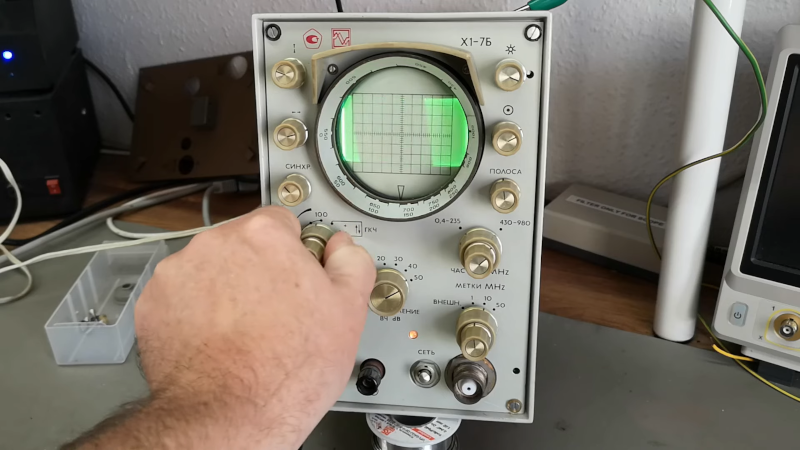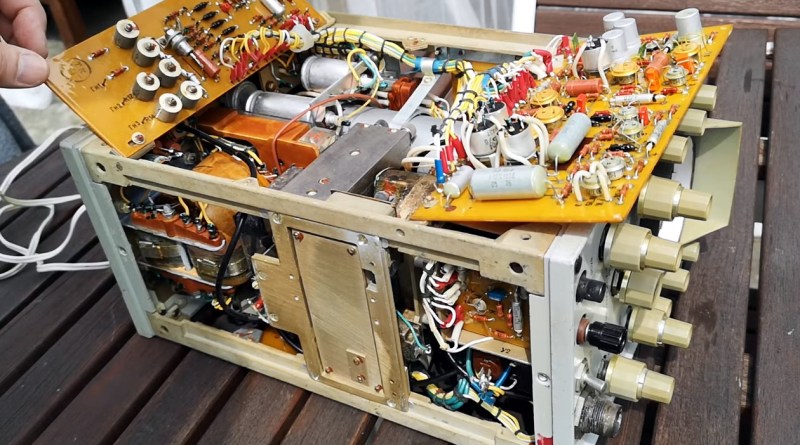Back in 1978, an oscilloscope was an exotic piece of gear for most homebrewers. We expect they were even more rare in private hands behind the iron curtain, and [Thomas Scherrer] shows us a Soviet X1-7B combination oscilloscope and spectrum analyzer (he thinks, at least, it is a spectrum analyzer) that he got working.
The Soviet scope is clearly different with its Cyrillic front panel. Luckily, Google Translate was up to the task of decoding a picture of the device. However, the differences aren’t just cosmetic. The scope also has a very interesting rotating bezel around the round CRT. You can see a video of the 8.2 kg scope below.
A quick look inside looks pretty conventional for a scope of that era that used all transistors in the circuitry. The rotating bezel, though, also controls something that looks like a big mechanical switch and cavity or, perhaps, a big mechanical variable component of some kind.
Satisfied that the insides were in reasonable shape, [Thomas] was ready to try turning it on. We want to say it went well, but… there was censored audio, along with a loud noise, right after it was plugged in. Troubleshooting centered on what was producing a burned smell, but a quick examination didn’t turn up anything obvious, despite being localized to the power circuitry. The fuse didn’t blow, oddly, and — even more puzzling — the unit was off when plugged in!
It turns out the input power filter leaked to the chassis. Since he had a ground on the chassis, that explained the failure, and while it was annoying, it was better than getting a shock with a hot chassis. The second plug in went better.
It finally did work, at least somewhat, although he never explored some of the odd features the scope appears to have. We love the old boat anchor scopes but don’t see many Soviet instruments, at least not those of us on this side of the Atlantic.
We do see a few Soviet-era computers now and again. As for the fuse not blowing, it was shorted before the fuse, but apparently, fuses don’t always blow when you expect them to, anyway.

















Haven’t watched the video yet, but from the description it smells like Rifa caps. :)
Definitely a funny meme and something to look out for, this isn’t the OPs first piece of old equipment. And Soviets didn’t use any Allied adjacent components if they didn’t have to(Ericsson is Swedish, technically neutral but cozy with western Europe and US). They were used primarily as AC mains filter caps and that’s where they fail. Soviets also used similar technology in that era, and recapping every paper cap is usually advised for any old electrics.
I also like to remind people to clarify which RIFA caps were especially prone to failure, it’s only the Paper and plastic foil in “clear”(translucent yellow) epoxy case that are prone to fail. I’ve seen too many new people trying to fix a late 90’s amp rip out perfectly good caps that have the word “RIFA” printed on them. Their electrolytics were as good as any other name brand, their modern caps are fine. I have used the PHE-450 series as Tesla Coil tank caps with no issues for a quarter of the cost of 942Cs.
What you’ve got there is a Soviet made wobbulator:
https://en.m.wikipedia.org/wiki/Wobbulator
It has a radio frequency signal generator that generates a frequency sweep. The CRT beam is synchronized to the sweep. There’s a pickup instead of a normal probe that converts the RF to a varying DC proportional to the input RF level.
Connect the sweep output to in input of a radio or TV IF filter. Connect the pickup to the scope input and you can see what the filter does to the signal.
You can’t analyse abitrary signals with it.
Soviet RIFAs ?
Soviet source? Concrete pad and blast wall far away from anything before plugging in.
Ohms check first, easy. Though it might have taken some voltage to blow through the caps. The lightbulb in series test is another way, where to get a lightbulb?
And old Variac from an electronics flea market or Hamfest is a great way to tease the power into old electronics with less smell and excitement.
The RCA WO-33A was a 5 MHz, AC-coupled oscilloscope available in 1960 for $130 assembled, $80 in kit form. Perhaps too expensive for a 12-year-old, but not out of range for a serious hobbyist.
This. And ‘scopes of this general sort were common enought that when I was about 12, in 1974, a friend of my father gave me an Eico ‘scope of 60s vintage. It was AC coupled and had synchronized sweep, not triggered, but for a 12 year old in 1974 it was quite useful. When I was older I made a triggered sweep circuit, using, of course, a 555 timer. A few years after that I got a Tektronix 535 at a Hamfest, head and shoulders above the Eico, but it took maybe $100 to buy it.